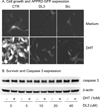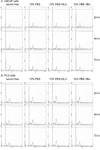Preferential induction of G1 arrest in androgen-responsive human prostate cancer cells by androgen receptor signaling antagonists DL3 and antiandrogen bicalutamide
- PMID: 20675041
- PMCID: PMC2956783
- DOI: 10.1016/j.canlet.2010.07.012
Preferential induction of G1 arrest in androgen-responsive human prostate cancer cells by androgen receptor signaling antagonists DL3 and antiandrogen bicalutamide
Abstract
The purpose of this study was to further characterize cell growth-inhibitory effects of a recently identified androgen receptor (AR) signaling inhibitor 6-amino-2-[2-(4-tert-butyl-pnenoxy)-ethylsulfanyl]-1H-pyrimidin-4-one (DL3)(5) and antiandrogen bicalutamide (Bic). DL3 was more potent than Bic in induction of G1 arrest and reduction of G1-related cell cycle protein expression in AR-positive LNCaP cells. DL3, but not Bic, moderately inhibited growth of AR-negative PC-3 cells independent of G1 arrest. The data indicated that DL3 inhibit cell growth in both AR-dependent and -independent manners and is potentially a potent therapeutic agent for the management of advanced human prostate cancer.
Published by Elsevier Ireland Ltd.
Conflict of interest statement
The authors declare no conflicts of interest.
Figures




Similar articles
-
A novel synthetic compound that interrupts androgen receptor signaling in human prostate cancer cells.Mol Cancer Ther. 2007 Jul;6(7):2057-64. doi: 10.1158/1535-7163.MCT-06-0735. Mol Cancer Ther. 2007. PMID: 17620434
-
Galbanic acid decreases androgen receptor abundance and signaling and induces G1 arrest in prostate cancer cells.Int J Cancer. 2012 Jan 1;130(1):200-12. doi: 10.1002/ijc.25993. Epub 2011 May 9. Int J Cancer. 2012. PMID: 21328348 Free PMC article.
-
Antagonistic interaction between bicalutamide (Casodex) and radiation in androgen-positive prostate cancer LNCaP cells.Prostate. 2010 Mar 1;70(4):401-11. doi: 10.1002/pros.21074. Prostate. 2010. PMID: 19902473
-
AR, the cell cycle, and prostate cancer.Nucl Recept Signal. 2008 Feb 1;6:e001. doi: 10.1621/nrs.06001. Nucl Recept Signal. 2008. PMID: 18301781 Free PMC article. Review.
-
Starving the addiction: new opportunities for durable suppression of AR signaling in prostate cancer.Clin Cancer Res. 2009 Aug 1;15(15):4792-8. doi: 10.1158/1078-0432.CCR-08-2660. Epub 2009 Jul 28. Clin Cancer Res. 2009. PMID: 19638458 Free PMC article. Review.
Cited by
-
Expression of FGD4 positively correlates with the aggressive phenotype of prostate cancer.BMC Cancer. 2018 Dec 17;18(1):1257. doi: 10.1186/s12885-018-5096-9. BMC Cancer. 2018. PMID: 30558664 Free PMC article.
-
NEK1 Phosphorylation of YAP Promotes Its Stabilization and Transcriptional Output.Cancers (Basel). 2020 Dec 7;12(12):3666. doi: 10.3390/cancers12123666. Cancers (Basel). 2020. PMID: 33297404 Free PMC article.
References
-
- Jemal A, Murray T, Ward E, Samuels A, Tiwari RC, Ghafoor A, Feuer EJ, Thun MJ. Cancer statistics, 2005. CA Cancer J. Clin. 2005;55:10–30. - PubMed
-
- Crawford ED. Challenges in the management of prostate cancer. Br. J. Urol. 1992;70 Suppl 1:33–38. - PubMed
-
- Miyamoto H, Rahman MM, Chang C. Molecular basis for the antiandrogen withdrawal syndrome. J. Cell. Biochem. 2004;91:3–12. - PubMed
-
- Aziz MH, Nihal M, Fu VX, Jarrard DF, Ahmad N. Resveratrol-caused apoptosis of human prostate carcinoma LNCaP cells is mediated via modulation of phosphatidylinositol 3'-kinase/Akt pathway and Bcl-2 family proteins. Mol. Cancer Ther. 2006;5:1335–1341. - PubMed
-
- Yuan H, Gong A, Young CY. Involvement of transcription factor Sp1 in quercetin-mediated inhibitory effect on the androgen receptor in human prostate cancer cells. Carcinogenesis. 2005;26:793–801. - PubMed
MeSH terms
Substances
Grants and funding
LinkOut - more resources
Full Text Sources
Research Materials

